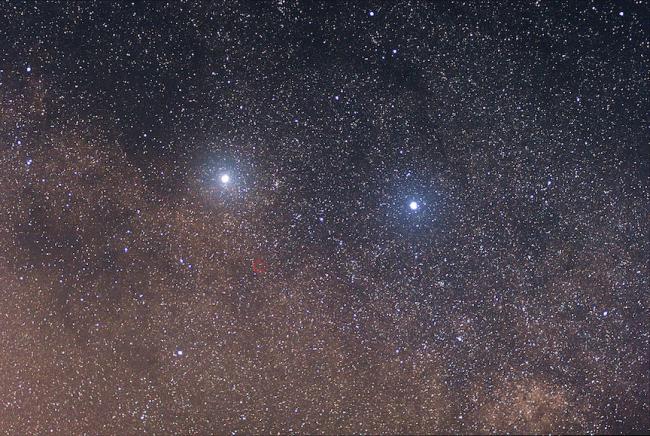
An optical image of the sky showing Alpha and Beta Centauri (bright stars to the left and right, respectively) and the M-dwarf Proxima Centauri, the closest star to the Sun (in the red circle). Astronomers conclude that low mass M-dwarfs like Proxmia Centauri anr unlikely to produce enough visible light to support photosynthesis in planets in their habitable zones.
Life on Earth is dominated by photosynthesis, the process by which green plants and some organisms use sunlight at visible wavelengths to synthesize carbon-based nutrients from carbon dioxide gas and water. Photosynthesis arose relatively early in Earth's evolutionary history, perhaps as long ago as three billion years. One of the important products of the associated chemical reaction is the release of oxygen molecules to the air, with dramatic consequences for the major evolutionary developments that were thereby enabled. It is estimated that after photosynthesis took hold, roughly six hundred million years were needed to oxygenate the Earth's atmosphere. So far about 4100 exoplanets are known, with about fifty that lie within their host star’s habitable zone where temperatures could permit surface liquid water to exist. Might photosynthesis be possible on some of these planets - and could we detect atmospheric oxygen or other signs of its activity?
CfA astronomers Manasvi Lingham and Avi Loeb analyzed the properties of one class of stars, M-dwarfs smaller than about 0.2 solar-masses. Although these kinds of stars are not the most similar ones to the Sun they are abundant, as are their planets. The closest star to the Sun, for example, Proxima Centauri, has a mass of only 0.12 solar-masses and it has an orbiting planet, Proxima Centauri b, that lies in its habitable zone. The problem for life is that these low mass stars are much cooler and dimmer than the Sun. Proxima Cen has a surface temperature of only about 3000K as compared with Sun’s surface temperature of 5780K. The cooler and dimmer surface results in much less visible light being available for photosynthetic reactions. The astronomers analyzed these stars (they also considered stars up to 2.5 times the Sun’s mass) and calculated whether they might be able to sustain Earth-like biospheres or host oxygen in their atmospheres. They also considered whether additional effects in low mass stars like flaring might contribute usefully to the visible light budget.
The scientists conclude, in agreement with earlier studies, that planets in the habitable zones around low-mass stars may not receive enough visible light to support Earth-like biospheres. They find, in particular, that although stars more massive than 0.21 solar-masses do provide sufficient light, less massive stars like Proxima Centauri are unlikely to be able to sustain photosynthesis or to build up atmospheric oxygen. Finally, they conclude that radiation from flares is not likely to be of much help. They also caution that a null detection of atmospheric oxygen in an exoplanet does not by itself exclude the possibility of photosynthetic life being present either because (at least in the case of a low mass star) not enough time has passed for the oxygen to accumulate or because the gas has dissipated.
"Photosynthesis on Habitable Planets Around Low-Mass Stars," Manasvi Lingam and Abraham Loeb, MNRAS 485, 5924, 2019.